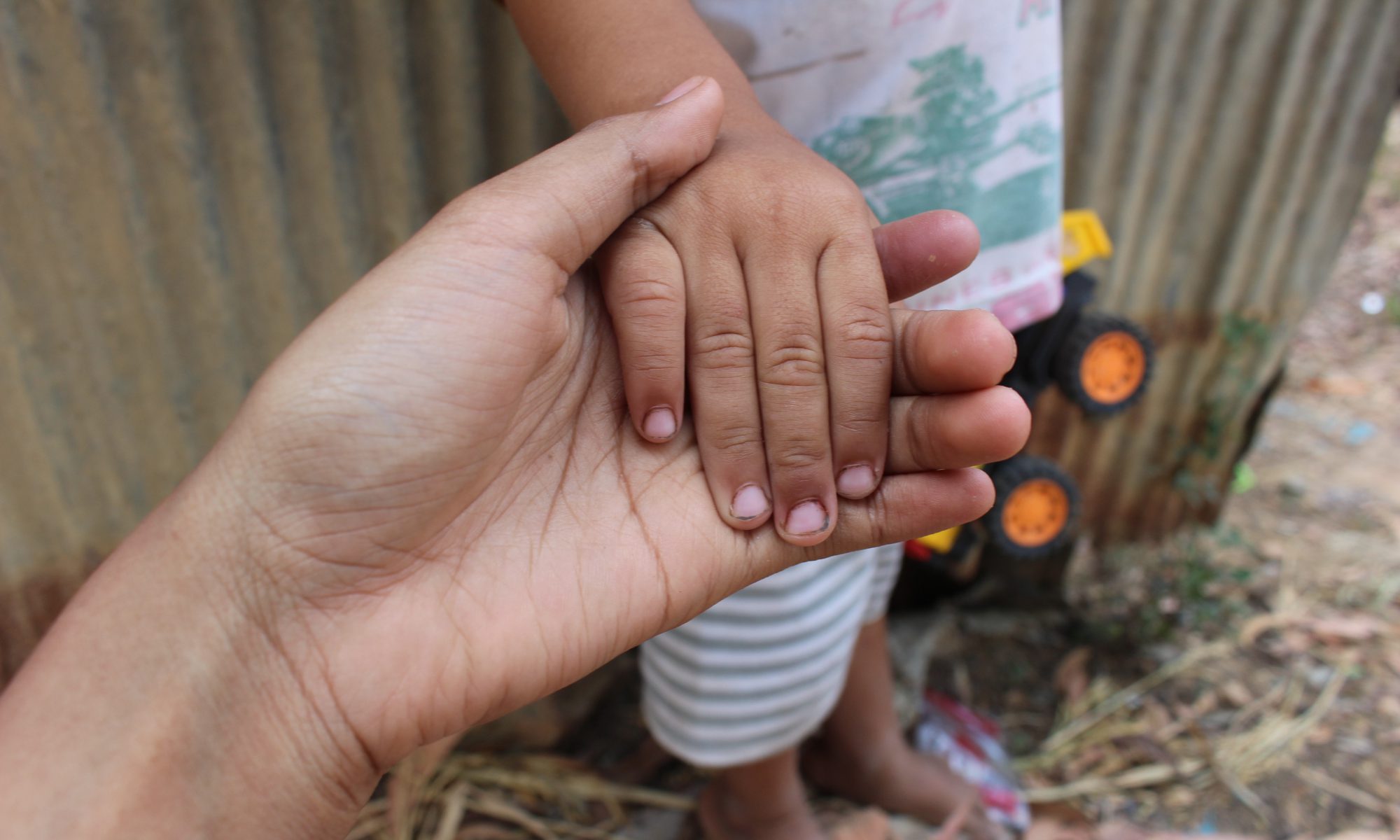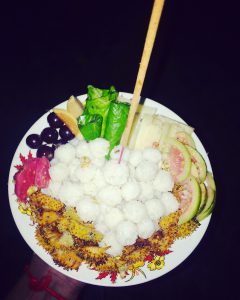Khmer English Phonetic
សំណាង : អួយ! សប្បាយចិត្តដល់ហើយ ពេលបានមកលេងសមុទ្រម្តងៗ!
Samnang : Oy! Sabay chet dol hery pel ban mok leng sa-mut
mdong-mdong!
Samnang : Oh! Everytime when I get here, I am so happy!!!
សុវណ្ណារី : ធ្វើមើលតែមួយលោកហ្នឹង មានតែឯង ។ ខ្ញុំក៏សប្បាយចិត្តដែរ ។
Sovannary : Tver merl tae mouy lok neg mean tae eng. K’nhom
kor sabay chet del.
Sovannary : Don’t pretend like there only you in this whole world. I’m also excited!
ឈឿ : មែនហើយ ទេសភាពនៅទីនេះស្រស់ស្អាតមែនទែន !
Chhoeu : Men hery tesapheap nov ti nis sros sart men ten!
Chhoeu : Yeb, The scenery here is very beautiful!
សំណាង : តែមានអារម្មណ៍ថា ដូចខុសប្លែកពីមុនយ៉ាងម៉េចទេ?
Samnang : Tae mean arom tha duch kos pleak pi mun yang mech
te.
Samnang : But, I kinda feel different than before?
សុវណ្ណារី : ប្លែកមែនតើ! ស្លាប់ហើយ មានសំរាមអណ្តែតលើទឹកទៀត ។
Sovannary : Pleak men toa! Slab hery mean somram ondet ler
tak tet.
Sovannary : Right! What! There are so many rubbishes
floating on the surface of the water.
ឈឿ : មិនមែនតែប៉ុណ្្ណឹងនោះទេ សូម្បីតែផ្កាថ្មក៏បាក់ ហើយអណ្តែតមកច្រាំងដែរ ។
Chhoeu : Min mean tae ponneng te sombey tae pkar thmor kor
bak hery ondet mok jhreg dae.
Chhoeu : Not only that, even corals are also get destroy and
float to the shore.
សុវណ្ណារី : ស្អីគេទៅហៅថាផ្កាថ្ម ? ខ្ញុំមិនដែលឮសោះ ! ហើយរាងវាមេ៉ចទៅ ?
Sovannary : S’ey ke tov hov tha pkar thmor? Khnom min dae
ler sos! Hery reg vea mech tov?
Sovannary : What is coral? I never heard of it! What does it
looks like?
ឈឿ : វាមានរាងខុសៗគ្នា ខ្លះបែកមែកសាខាដូចដើមឈើ ខ្លះក្រញាញ់ដូចខួរក្បាល
មនុស្ស ខ្លះមានរាងដូចជាបណ្តុំផ្កា ហើយខ្លះមានរាងដូចស្លឹកឈូក ។ សុវណ្ណារីមានដឹង
អត់ថាផ្កាថ្មប្រភេទនេះ មានតួនាទីសំខាន់ណាស់ក្នុងការជួយចម្រុះទឹកសមុទ្រឲ្យស្អាត ?
Chhoeu : Vea mean reg kos kos knea, klas bek mek sa-kha duch
dem chheu, klas kro nheanh duch khu-kbar monus, klas mean
reg duch chea bom-dom pkar hery klas mean reg duch sleak
chuk. Sovannary mean deg ort tha pkar thmor pro-hel nis mean
tur nea-ti somkhan nas knong ka jouy jom-ross tak samut oy
sart.
Chhoeu : It’s come in so many different shapes, some are like
the tree branches, some are like human brain, and some are
like flowers. Sovannary, do you know that corals are very
important for water filter?
សំណាង: ពួកយើងមានដឹងថា ផ្កាថ្មរងផលប៉ះពាល់អ្វីខ្លះដែរអត់ ?
Samnang : Puk yerng mean deng tha pkar thmor rong phal phas
por avey klas dae ort?
Samnang : Do you know any effects on coral?
សុវណ្ណារី : ស្រួលណាស់! មកពីមនុស្សយើងឃើញថាវាស្អាត ទើបកាច់វាមកសៀតនៅនឹង
សក់ ។
Sovananry : Sroul nas! Mok pi mnous yerng khernh tha va sa
art terb kach vea mok siet nov ning sok.
Sovanarry : That’s easy! Because our human think that it’s
pretty while taking taking it to decorate our hair.
សំណាង : ចម្លើយល្អមែនតែមិនត្រឹមត្រូវទេ !
Samnang : Chom lery laor men tae min trem trov te!
Samnang: Good answer but that’s incorrect!
ឈឿ : ហិ ! ហិ ! ហិ ! ហិ ! ផ្កាថ្ម ទទួលផលប៉ះពាល់មកពីព្យុះធម្មជាតិ !
Chhoeu : he he he he! P’kah thmor t’tuol phal pas peal mok pi
p’youh thoma cheate!
Chhoeu : He he heh he! Coral get the effects from natural
disaster.
សំណាង : ក្រៅពីព្យុះធម្មជាតិ វាក៏បណ្តាលមកពីការនេសាទខុសច្បាប់ ដែលមានដូចជា
អូសអួនធំៗ ហើយពេលអូសម្តងៗ ធ្វើអោយស្រទាប់នៅបាតសមុទ្រត្រូវបានបំផ្លិត
បំផ្លាញ ការបោកគ្រាប់បែក ការដាក់ថ្នាំពុល កត្តានេះហើយ គឺជាហានិភ័យដ៏ធំមួយ
ដែលគួរអោយភ័យខ្លាច ។
Samnang : Krav pi p’youh toma cheate vea kor bun dal mok pi
kah nesart khous j’bab del mean doch jea ous ourn thom thom
hery pel ous m’dong m’dong tver oy srotorb nov bat samut
trov ban bomplech bomplanh kah bouk kroub baek, kah dak
thnam pol, k’tah nis hery kur jea hah niphey dor thom mouy
del kur oy phey klach
Samnang : In additions to the natural storms, it’s also caused by illegal fishing, such as large drag, when dragged, the substrate layer get destroyed. Bombing and poisoning, all of this risks are very scary.
សុវណ្ណារី : ហានិភ័យ !? ផ្កាថ្មធម្មតាហ្នឹង? បាត់វាមួយ ក៏នៅសល់អាផ្សេងទៀតដែរ
ចាំបាច់បារម្មណ៍អី ។
Sovannary : Hah niphey? Pkah tomada ning? Bat vea mouy kor
nov sol ah p’seng teat del jam bech barom ey.
Sovannary : Risk? Just a coral, lose it one, there is the
rest of the other, no need to worry.
សំណាង : ផ្កាថ្មទាំងនេះ មានសារ:សំខាន់ណាស់ !
Samnang : Pkah thmor tang os nis mean sarak somkhan nas!
Samnang : All of this corals are so important.
សុវណ្ណារី : ខ្ញុំដឹងហើយ គឺវាជួយចម្រុះទឹកអោយស្អាត ។
Sovannary : K’nhom ding hery kir vea jouy jom ros tik oy sa
art.
Sovannary : I know! It helps to filter the water.
ឈឿ : បាទ ! ក្រៅពីចម្រុះទឹក វាក៏ជាជម្រករបស់សត្វដ៏ទៃ ដូចជាពពួកត្រីត្លុក
អន្ទង់ ត្រីខ្យាដំរី ខ្ញែ សមុទ្រ ផ្កាយសមុទ្រ ហើយវាក៏ជាអាហារសំរាប់សត្វដ៏ទៃផងដែរ ។
Chheou : Bart! Krav pi jom ros tik vea kor jea jom rok robos
saat dor tei doch jea p’pok trey tlok on-tong trey kh’yah
domrey khnhae sakmut pkye sakmut hery vea kor jea ah hah
somrab saat dor tei teat pong.
Chheou: Yes! Beside filtering the water, it’s also a habitats for other marine lives, such as comic fish, eels, scorpion fish, jellyfish, starfish, and also provide food to the other animals.
សំណាង : មើលទៅផ្កាថ្មទាំងនេះ លូតលាស់លឿនជាងខ្ញុំទៀតណ៎ !
Samnang : Merl tov pka thmor teang os nis lout leus leun
cheang khnom teat nor!
Samnang : Look at all of this corals, it grows way faster
than me.
ឈឿ : មិនមែនទេ ! ផ្កាថ្មទាំងនេះ លូតលាស់យឺតណាស់ ។ ក្នុងមួយឆ្នាំ វាអាចលូត
បាន៣សង់ទីមែ៉ត្រ ទៅ៥សង់ទីមែត្រតែប៉ុណ្ណោះ ។
Chhoeu: min man te! Pka thmor teang nis lout leus yuet nas.
Knong mouy cham vea kout ban bei song ti met tov pram song
ti maet tae bon-nos.
Chheou : No! All of this coral reefs grow really slow. In
one year, it's can grow up only for 3 centimeters or 5
centimeters.
សុុវណ្ណារី : អីញ្ចឹង! វាត្រូវការរាប់រយឆ្នាំដើម្បីក្លាយជាផ្កាថ្មដែលធំមួយត្រូវអត់ ?
Sovannary : Anh jing! Vea trov kar roub roy chnam dermbey
klaay jea pkah thmor del thom mouy del trov ot?
Sovannary : So, it needs hundred of years to form into a big
coral reefs right?
ឈឿ : ឆ្លាតមែន !
Chheou : Chlat men!
Chheou : So smart!
សំណាង : បើឆ្លាតអីញ្ចឹងខ្ញុំសួរមួយ! តើយើងគួរតែធ្វើយ៉ាងម៉េច ដើម្បីកុំអោយបាត់
បង់ផ្កាថ្មនូវថ្ងៃមុខ ?
Samnang : ber chalt anh jing khnhom sur mouy! Ter yerng kur
tver yang mech dermbey kom oy bat bong pkah thmor nov
thngai muk?
Samnang : If you’re that smart! Let me me ask you one
question, what can we all do to prevent from losing the
coral reefs.
សុុវណ្ណារី : ខ្ញុំគិតថា យើងគួរតែរួមគ្នាអភិរក្សផ្កាថ្ម ក៏ដូចជាជីវ:ចម្រុះដ៏ទៃទៀតដែរ ។
ពួកយើងត្រូវតែបញ្ឈប់រាល់សកម្មភាពខុសច្បាប់គ្រប់ប្រភេទ ឈប់ចោលសំរាមផ្តេសផ្តាស់
ហើយនាំគ្នាចាប់ផ្តើមសំអាតសមុទ្រចាប់ពីថ្ញៃនេះទៅ និងចូលរួមផ្សព្វផ្សាយពីវា ។
Sovannary : Knhom kit tha yerng kur tae rum knea ak phy rak
pkah thmor kor doch jea jivak chom ros dor tei del.
Sovannary : I think we all should jointly conserve coral, as
well as other biodiversity.
ឈឿ : ឆ្លើយបានល្អណាស់ !
Chhoeu : Chhlaey ban laor nas!
Chhoeu : Good answer!
សុុវណ្ណារី : ចុះបើយើងមានផ្កាថ្មដែលមានសុខភាពល្អហើយ ! តើវានឹងមានផលប្រយោ
ជន៍អ្វីខ្លះដល់ប្រទេសជាតិយើងក៏ដូចជាយើងផ្ទាល់
Sovannary : Jos ber yerng mean pkar tmor del mean sok-pheap
laor hery! Tao vea ning mean phul bro-yoch avey klas dol
protis chet yerng kor duch chea yerng ptol.
Sovannary : What are the affects from the healthy coral to
Cambodia?
សំណាង : ផលប្រយោជន៍នោះគឺ យើងនឹងមានសមុទ្រមួយដែលពោរពេញទៅដោយភាព
ស្អាតស្រស់ថ្លា ។
Samnang : phul bro-yoch nos ker yerng nig mean samut mouy
del pol peng tov doy pheap sart sros thla.
Samnang : As a result the effect would turn out into a
beautiful ocean.
ឈឿ : កំណើនភ្ញៀវទេសចរណ៍នឹងកើនឡើង ! ហើយសេដ្ឋកិច្ចយើងក៏រីកចម្រើនទៅ
តាមកំណើនភ្ញៀវទេសចរណ៍ អាហារសមុទ្រដែលយើងបានលក់ និងផលិតផលផ្សែងៗ ។
Chhoeu : Kom-nern phnhiev tesajor neng kern lerng! Hery
sech-tha-kech yerng kor rik jom-rean tov tam kom-nern
phnhiev tesajor ah-ha samut del yerng ban luk nig polit
phul pheng-pheng.
Chhoeu : The tourism growth will increase! Our economy will
also develop based on the tourists, seafood and other local
products.
សំណាង : អ្នកនេសាទក៏អាចរកលុយពីភ្ញៀវទេសចរណ៍បានដែរ ។
Samnang : Nak nesat kor ach rok luy pi phnhiev tesajor ban
del.
Samnang : The fishermen financials also can come from the
tourists.
សុុវណ្ណារី : នាទីនេះ ឧបត្ថម្ហដោយ អង្គការសត្វព្រៃ និងរុក្ខជាតិអន្តរជាតិ FFI ប្រចាំ
នៅកម្ពុជា សហការជាមួយ ក្រសួងកសិកម្ម រុក្ខាប្រមាញ់ និងនេសាទ ក្នុងការការពារ
ប្រភេទសត្វ ឬរុក្ខជាតិ ដែលទទួលរងការគំរាមកំហែង ព្រមទាំងជួយលើកស្ទួយនៅ
វិស័យសេដ្ឋកិច្ច ។
Sovananry : Near-ti nis obpatom doy angkar sat-prei nig
rukka chet ontrak chet FFI brojam nov Kampuchea sahakar chea
mouy krosuog kaksekam rokha bromag nig nesat knong kar kar-
phea bro phet sat reu rukha chet del tortul rong kar kom
ream kom haeng prom teang juy leuk stuoy nov visey
sech-tha-kech.
Sovannary : This episode was funded by Fauna and Flora
Cambodia, partnered with the Ministry of Agriculture
Forestry and Fisheries in order to protect all plants and
animals species that are endangered as well as helping the
growth of the country’s economy.
សំណាង : ចូលរួមរាយការណ៍រាល់សកម្មភាពនេសាទខុសច្បាប់ ដែលអ្នកបានឃើញ
តាមរយ:លេខទូរស័ព្ទ 0១២ ៩០៨ ១២១ ។
Samnang : Jol rum rey kar rol sakam-pheap nesat kus chbab
del nak ban rok kheunh tam royak lek tour-sap 012 908 121.
Samnang : Inform us with any illegal fishing that you seen
by 012 908 121.
សុុវណ្ណារី : អភិរក្សសត្វសមុទ្រ
Sovannary : ak phy rak sat samut
Sovannary : Conserve our marine animals
សំណាង : ដើម្បីភាពស្រស់ថ្លា
Samnang : Dermbey pheap sros thlar
Samnang : For refreshness
ឈឿ : ជាអនាគតនៃសេដ្ឋកិច្ច
Chhoeu : Chea ah na kot nei sech-tha-kech.
Chhoeu : And for the future of the economy growth.

